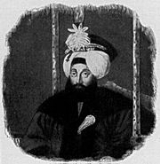
Great Bosnian uprising
Encyclopedia
The Bosnian uprising was a revolt of Bosnian Muslims against the Ottoman Empire
, which began on March 29, 1831.
Despite winning several notable victories, the rebels were eventually defeated in a battle near Sarajevo in 1832. Internal discord contributed to the failure of the rebellion, because Gradaščević was not supported by much of the Herzegovinian nobility.
The rebellion was extinguished by 1850, but the Ottoman Empire continued to decline.
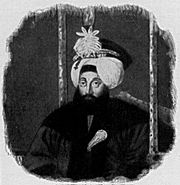
In the late 1820s, Sultan Mahmud II
reintroduced a set of reforms that called for further expansion of the centrally controlled army (nizam), new taxes and more Ottoman bureaucracy. These reforms weakened the special status and privileges Bosnian beys had enjoyed under the Ottoman Empire and coupled with the growing power and position of other European people under Ottoman control caused much anger and alarm. Contrary to popular belief, however, the future leader of the autonomy movement, Husein Gradaščević
, then just a local official, was not greatly opposed to these reforms.
In 1826, when the Sultan issued a decree abolishing the janissaries
in Bosnia, Gradaščević's immediate reaction was not unlike that of the rest of the Bosnian aristocracy. Gradaščević threatened that he would use military force to subdue anybody opposed to the Sarajevo janissaries. When the janissaries killed nakibul-ešraf Nuruddin Efendi Šerifović, however, his tone shifted and he rapidly distanced himself from their cause.
For the rest of the 1820s, Gradaščević generally maintained good relations with imperial authorities in Bosnia. When Abdurrahim-paša became vizier in 1827, Gradaščević was said to have become one of his more trusted advisors. This culminated in Gradaščević's large role in the Bosnian mobilization for the Russo-Ottoman war. Following a riot in the Sarajevo camp during these preparations, Gradaščević even provided shelter for the ousted Abdurrahim-paša in Gradačac before assisting him in his escape from the country. Gradaščević was also relatively loyal to Abdurrahim's successor, Namik-paša, reinforcing Ottoman garrisons in Šabac
upon his orders.
The turning point for Gradaščević came with the end of the Russo-Ottoman War of 1828–1829 and the Treaty of Adrianople
on September 14, 1829. According to the provisions of the treaty and a subsequent Hatt-i Sharif
, the Ottoman Empire granted suzerainty
to Serbia
as a result of the Serbian revolution
. In a move that outraged Bosniaks and launched numerous protests, newly autonomous Serbia was also given six districts (Bosnian: nahijas) that had traditionally belonged to Bosnia. Following this move, seen as the confiscation of historically Bosnian lands, the Bosnian autonomy movement was born.
Between the 20th and 31 December 1830, Gradaščević hosted a gathering of Bosniak aristocrats in Gradačac. A month later, from January 20 to February 5, another meeting was held in Tuzla
to prepare for the revolt. From there, a call was issued to the Bosnian populace asking them to rise up to the defense of Bosnia. It was then that the popular Husein-kapetan was unofficially chosen to head the movement.
. Since Travnik was the seat of the Bosnian pashaluk and the vizier, the planned meeting was in effect a direct confrontation with Ottoman authority. Gradaščević thus asked all involved to help assemble an army beforehand. On March 29, 1831, Gradaščević set out towards Travnik with some 4,000 men.
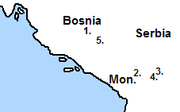 Upon hearing word of the oncoming force, Namik-paša is said to have gone to the Travnik fort and called the Sulejmanpašić brothers to his aid. When the rebel army arrived in Travnik they fired several warning shots at the castle, warning the vizier that they were prepared for a military encounter. Meanwhile, Gradaščević sent a detachment of his forces, under the command of Memiš-aga of Srebrenica
Upon hearing word of the oncoming force, Namik-paša is said to have gone to the Travnik fort and called the Sulejmanpašić brothers to his aid. When the rebel army arrived in Travnik they fired several warning shots at the castle, warning the vizier that they were prepared for a military encounter. Meanwhile, Gradaščević sent a detachment of his forces, under the command of Memiš-aga of Srebrenica
, to meet Sulejmanpašić's reinforcements.
The two sides met at Pirot
, on the outskirts of Travnik, on April 7. There, Memiš-aga defeated the Sulejmanpašić brothers and their 2,000-man army, forcing them to retreat and destroying the possessions of the Sulejmanpašić family. On May 21, Namik-paša fled to Stolac
following a short siege
. Soon afterwards, Gradaščević proclaimed himself the Commander of Bosnia, chosen by the will of the people.
Gradaščević made a call on May 31 demanding that all aristocrats immediately join his army, along with all from the general populace who wished to do so. Thousands rushed to join him, among them numerous Christians, who were said to comprise up to a third of his total forces. Gradaščević split his army in two, leaving one part of it in Zvornik
to defend against a possible Serbian incursion. With the bulk of the troops he set out towards Kosovo to meet the grand vizier, who had been sent with a large army to quell the rebellion. Along the way, he took the cities of Peć
and Pristina
, where he set up his main camp.
The encounter with Grand Vizier Mehmed Rashid-paša happened on July 18 near Shtimje/Štimlje. Although both armies were of roughly equal size, the Grand Vizier's troops had superior arms. Gradaščević sent a part of his army under the command of Ali-beg Fidahić ahead to meet Rashid-paša 's forces. Following a small skirmish, Fidahić feigned a retreat. Thinking that victory was within reach, the Grand Vizier foolishly sent his cavalry and artillery into forested terrain. Gradaščević immediately took advantage of this tactical error and executed a punishing counterattack with the bulk of his forces, almost completely annihilating the Ottoman forces. Rashid-paša himself was injured and barely escaped with his life.
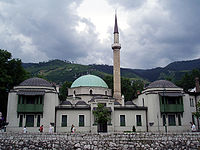
. At this meeting it was decided that Gradaščević should be declared vizier of Bosnia.
Although Gradaščević refused at first, those around him insisted and he eventually accepted the honor. His new status was made official during an all-Bosnian congress held in Sarajevo
on September 12. In front of the Emperor's Mosque
, those present swore on the Qur'an
to be loyal to Gradaščević and declared that, despite potential failure and death, there would be no turning back.
At this point, Gradaščević was not only the supreme military commander, but Bosnia's leading civilian authority as well. He established a court around him, and after initially making himself at home in Sarajevo
, he moved the center of Bosnian politics to Travnik
, making it the de facto capital of the rebel state.
In Travnik, he established a Divan
, a Bosnian congress, which together with him made up the Bosnian government. Gradaščević also collected taxes at this time, and executed various local opponents of the autonomy movement. He gained a reputation as a hero and a strong, brave, and decisive ruler. One anecdote that illustrates this is Husein-kapetan's alleged response to whether he was scared of waging war against the Ottoman Empire. God I fear slightly, Gradaščević replied, the Sultan not at all, and the Grand Vizier no more than my own horse.
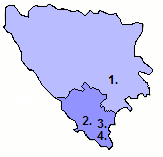
As it happened, Namik-paša had already abandoned Stolac, so this attack was put on hold. The attack on Gacko was a failure as the forces from Posavina and south Podrinje were defeated by Čengić's troops. There was one success, however; in October, an army Gradaščević had deployed under the command of Ahmed-beg Resulbegović had taken over Trebinje
from Resulbegović's loyalist cousins and other supporters of the Stolac opposition.
A Bosnian delegation reached the Grand Vizier's camp in Skopje
in November of that year. The Grand Vizier promised this delegation that he would insist to the Sultan that he accept the Bosniak demands and appoint Gradaščević as the official vizier of an autonomous Bosnia. His true intentions, however, were manifested by early December when he attacked Bosnian units stationed on the outskirts of Novi Pazar
. Yet again, the rebel army handed a defeat to the imperial forces. Due to a particularly strong winter though, the Bosnian troops were forced to return home.
Meanwhile in Bosnia, Gradaščević decided to carry on his campaign in Herzegovina despite the unfavorable climate. The captain of Livno
, Ibrahim-beg Fidrus, was ordered to launch a final attack against the local captains and to thus end all domestic opposition to the autonomy movement. To achieve this, Fidrus first attacked Ljubuški
and the local captain Sulejman-beg. In a significant victory, Fidrus defeated Sulejman-beg and secured the whole of Herzegovina except Stolac in the process. Unfortunately, the segment of the army that laid siege to Stolac itself met with failure in early March of the next year. Receiving information that the Bosnian ranks were depleted due to the winter, the captain of Stolac Ali-paša Rizvanbegović
broke the siege, counterattacking the rebels and dispersing their forces. A force had already been sent towards Stolac from Sarajevo, under the command of Mujaga Zlatar, but was ordered back by Gradaščević on March 16 after he received news of a major offensive on Bosnia being planned by the Grand Vizier.
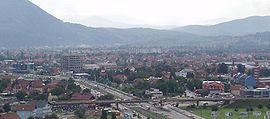
and one from Shkodër
. Both armies headed toward Sarajevo, and Gradaščević sent an army of around 10,000 men to meet them. When the Vizier's troops succeeded in crossing the Drina
, Gradaščević ordered 6,000 men under Ali-paša Fidahić to meet them in Rogatica
while units stationed in Višegrad
were to head to Pale
on the outskirts of Sarajevo. The encounter between the two sides finally happened on the Glasinac plains to the east of Sarajevo, near Sokolac
, at the end of May. The Bosnian army was led by Gradaščević himself, while the Ottoman troops were under the command of Kara Mahmud Hamdi-paša, the new imperially recognized vizier of Bosnia. In this first encounter, Gradaščević was forced to retreat to Pale. The fighting continued in Pale and Gradaščević was once again forced to retreat; this time to Sarajevo. There, a council of captains decided that the fight would continue.
, a small locality on the road between Sarajevo and Ilidža
. After a long, intense battle, it seemed Gradaščević had once again defeated the Sultan's army. Near the very end, however, Herzegovinian troops under the command of Ali-paša Rizvanbegović
and Smail-aga Čengić broke through defenses Gradaščević had set up on his flank and joined the fighting. Overwhelmed by the unexpected attack from behind, the rebel army was forced to retreat into the city of Sarajevo itself. It was decided that further military resistance would be futile. Gradaščević fled to Gradačac as the imperial army entered the city on June 5 and prepared to march on Travnik. Upon realizing the difficulties that his home and family would experience if he stayed there, Gradaščević decided to leave Gradačac and continue on to Austria
n lands instead.
Ottoman Empire
The Ottoman EmpireIt was usually referred to as the "Ottoman Empire", the "Turkish Empire", the "Ottoman Caliphate" or more commonly "Turkey" by its contemporaries...
, which began on March 29, 1831.
Despite winning several notable victories, the rebels were eventually defeated in a battle near Sarajevo in 1832. Internal discord contributed to the failure of the rebellion, because Gradaščević was not supported by much of the Herzegovinian nobility.
The rebellion was extinguished by 1850, but the Ottoman Empire continued to decline.
The road to uprising

In the late 1820s, Sultan Mahmud II
Mahmud II
Mahmud II was the 30th Sultan of the Ottoman Empire from 1808 until his death in 1839. He was born in the Topkapi Palace, Istanbul, the son of Sultan Abdulhamid I...
reintroduced a set of reforms that called for further expansion of the centrally controlled army (nizam), new taxes and more Ottoman bureaucracy. These reforms weakened the special status and privileges Bosnian beys had enjoyed under the Ottoman Empire and coupled with the growing power and position of other European people under Ottoman control caused much anger and alarm. Contrary to popular belief, however, the future leader of the autonomy movement, Husein Gradaščević
Husein Gradašcevic
Husein-kapetan Gradaščević was a Bosnian Muslim general who fought for Bosnian autonomy in the Ottoman Empire. He is often referred to as "Zmaj od Bosne", meaning "Dragon of Bosnia"...
, then just a local official, was not greatly opposed to these reforms.
In 1826, when the Sultan issued a decree abolishing the janissaries
Janissary
The Janissaries were infantry units that formed the Ottoman sultan's household troops and bodyguards...
in Bosnia, Gradaščević's immediate reaction was not unlike that of the rest of the Bosnian aristocracy. Gradaščević threatened that he would use military force to subdue anybody opposed to the Sarajevo janissaries. When the janissaries killed nakibul-ešraf Nuruddin Efendi Šerifović, however, his tone shifted and he rapidly distanced himself from their cause.
For the rest of the 1820s, Gradaščević generally maintained good relations with imperial authorities in Bosnia. When Abdurrahim-paša became vizier in 1827, Gradaščević was said to have become one of his more trusted advisors. This culminated in Gradaščević's large role in the Bosnian mobilization for the Russo-Ottoman war. Following a riot in the Sarajevo camp during these preparations, Gradaščević even provided shelter for the ousted Abdurrahim-paša in Gradačac before assisting him in his escape from the country. Gradaščević was also relatively loyal to Abdurrahim's successor, Namik-paša, reinforcing Ottoman garrisons in Šabac
Šabac
Šabac is a city and municipality in western Serbia, along the Sava river, in the historic region of Mačva. It is the administrative center of the Mačva District. The city has a population of 52,822 , while population of the municipality is 115,347...
upon his orders.
The turning point for Gradaščević came with the end of the Russo-Ottoman War of 1828–1829 and the Treaty of Adrianople
Treaty of Adrianople
The Peace Treaty of Adrianople concluded the Russo-Turkish War, 1828-1829 between Russia and the Ottoman Empire. It was signed on September 14, 1829 in Adrianople by Russia's Count Alexey Fyodorovich Orlov and by Turkey's Abdul Kadyr-bey...
on September 14, 1829. According to the provisions of the treaty and a subsequent Hatt-i Sharif
Hatt-i Sharif
The Hatt-i Sharif of Gülhane or Tanzimât Fermânı was an 1839 proclamation by Ottoman Sultan Abdülmecid I that launched the Tanzimât period of reforms and reorganization....
, the Ottoman Empire granted suzerainty
Suzerainty
Suzerainty occurs where a region or people is a tributary to a more powerful entity which controls its foreign affairs while allowing the tributary vassal state some limited domestic autonomy. The dominant entity in the suzerainty relationship, or the more powerful entity itself, is called a...
to Serbia
Serbia
Serbia , officially the Republic of Serbia , is a landlocked country located at the crossroads of Central and Southeast Europe, covering the southern part of the Carpathian basin and the central part of the Balkans...
as a result of the Serbian revolution
Serbian revolution
Serbian revolution or Revolutionary Serbia refers to the national and social revolution of the Serbian people taking place between 1804 and 1835, during which this territory evolved from an Ottoman province into a constitutional monarchy and a modern nation-state...
. In a move that outraged Bosniaks and launched numerous protests, newly autonomous Serbia was also given six districts (Bosnian: nahijas) that had traditionally belonged to Bosnia. Following this move, seen as the confiscation of historically Bosnian lands, the Bosnian autonomy movement was born.
Between the 20th and 31 December 1830, Gradaščević hosted a gathering of Bosniak aristocrats in Gradačac. A month later, from January 20 to February 5, another meeting was held in Tuzla
Tuzla
Tuzla is a city and municipality in Bosnia and Herzegovina. At the time of the 1991 census, it had 83,770 inhabitants, while the municipality 131,318. Taking the influx of refugees into account, the city is currently estimated to have 174,558 inhabitants...
to prepare for the revolt. From there, a call was issued to the Bosnian populace asking them to rise up to the defense of Bosnia. It was then that the popular Husein-kapetan was unofficially chosen to head the movement.
Rising tide and early succeses
Another outcome of the Tuzla meeting was an agreement that another general meeting should be held in TravnikTravnik
Travnik is a city and municipality in central Bosnia and Herzegovina, 90 km west of Sarajevo. It is the capital of the Central Bosnia Canton, and is located in the Travnik Municipality. Travnik today has some 27,000 residents, with a metro population that is probably close to 70,000 people...
. Since Travnik was the seat of the Bosnian pashaluk and the vizier, the planned meeting was in effect a direct confrontation with Ottoman authority. Gradaščević thus asked all involved to help assemble an army beforehand. On March 29, 1831, Gradaščević set out towards Travnik with some 4,000 men.

Srebrenica
Srebrenica is a town and municipality in the east of Bosnia and Herzegovina, in the Bosnian Serb entity of Republika Srpska. Srebrenica is a small mountain town, its main industry being salt mining and a nearby spa. During the Bosnian War, the town was the site of the July 1995 massacre,...
, to meet Sulejmanpašić's reinforcements.
The two sides met at Pirot
Pirot
Pirot is a town and municipality located in south-eastern Serbia. According to 2011 census, the town has a total population of 38,432, while the population of the municipality is 57,911...
, on the outskirts of Travnik, on April 7. There, Memiš-aga defeated the Sulejmanpašić brothers and their 2,000-man army, forcing them to retreat and destroying the possessions of the Sulejmanpašić family. On May 21, Namik-paša fled to Stolac
Stolac
Stolac is a town and municipality in Bosnia and Herzegovina, located in the southern part of Herzegovina. Administratively, it is part of the Herzegovina-Neretva Canton in the Federation of Bosnia and Herzegovina....
following a short siege
Siege
A siege is a military blockade of a city or fortress with the intent of conquering by attrition or assault. The term derives from sedere, Latin for "to sit". Generally speaking, siege warfare is a form of constant, low intensity conflict characterized by one party holding a strong, static...
. Soon afterwards, Gradaščević proclaimed himself the Commander of Bosnia, chosen by the will of the people.
Gradaščević made a call on May 31 demanding that all aristocrats immediately join his army, along with all from the general populace who wished to do so. Thousands rushed to join him, among them numerous Christians, who were said to comprise up to a third of his total forces. Gradaščević split his army in two, leaving one part of it in Zvornik
Zvornik
Zvornik is a city on the Drina river in northeastern Bosnia and Herzegovina, located south of the town of Bijeljina in Bosnia and Herzegovina. The town Mali Zvornik lies directly across the river in Serbia, and not far north is Loznica.-History:Zvornik is first mentioned in 1410, although it was...
to defend against a possible Serbian incursion. With the bulk of the troops he set out towards Kosovo to meet the grand vizier, who had been sent with a large army to quell the rebellion. Along the way, he took the cities of Peć
Pec
Peć or Pejë is a city and municipality in north-western Kosovo and Metohija - Serbia, and the administrative centre of the homonymous district. Governor of city is Ali Berisha....
and Pristina
Pristina
Pristina, also spelled Prishtina and Priština is the capital and largest city of Kosovo. It is the administrative centre of the homonymous municipality and district....
, where he set up his main camp.
The encounter with Grand Vizier Mehmed Rashid-paša happened on July 18 near Shtimje/Štimlje. Although both armies were of roughly equal size, the Grand Vizier's troops had superior arms. Gradaščević sent a part of his army under the command of Ali-beg Fidahić ahead to meet Rashid-paša 's forces. Following a small skirmish, Fidahić feigned a retreat. Thinking that victory was within reach, the Grand Vizier foolishly sent his cavalry and artillery into forested terrain. Gradaščević immediately took advantage of this tactical error and executed a punishing counterattack with the bulk of his forces, almost completely annihilating the Ottoman forces. Rashid-paša himself was injured and barely escaped with his life.

Rebel government established
Following claims from the Grand Vizier that the Sultan would meet all Bosniak demands if the rebel army would return to Bosnia, Gradaščević and his army turned back home. On August 10 a meeting of all major figures in the movement for autonomy was held in PristinaPristina
Pristina, also spelled Prishtina and Priština is the capital and largest city of Kosovo. It is the administrative centre of the homonymous municipality and district....
. At this meeting it was decided that Gradaščević should be declared vizier of Bosnia.
Although Gradaščević refused at first, those around him insisted and he eventually accepted the honor. His new status was made official during an all-Bosnian congress held in Sarajevo
Sarajevo
Sarajevo |Bosnia]], surrounded by the Dinaric Alps and situated along the Miljacka River in the heart of Southeastern Europe and the Balkans....
on September 12. In front of the Emperor's Mosque
Emperor's Mosque
The Emperor's Mosque is an important mosque in Sarajevo, Bosnia and Herzegovina.It was built by Isa-bey Ishakovich-Hranushich, as the first mosque in Sarajevo, in 1457 and it was dedicated to the Sultan Mehmed the 2nd, El-Fatih.First settlements in Sarajevo were built around the mosque, and...
, those present swore on the Qur'an
Qur'an
The Quran , also transliterated Qur'an, Koran, Alcoran, Qur’ān, Coran, Kuran, and al-Qur’ān, is the central religious text of Islam, which Muslims consider the verbatim word of God . It is regarded widely as the finest piece of literature in the Arabic language...
to be loyal to Gradaščević and declared that, despite potential failure and death, there would be no turning back.
At this point, Gradaščević was not only the supreme military commander, but Bosnia's leading civilian authority as well. He established a court around him, and after initially making himself at home in Sarajevo
Sarajevo
Sarajevo |Bosnia]], surrounded by the Dinaric Alps and situated along the Miljacka River in the heart of Southeastern Europe and the Balkans....
, he moved the center of Bosnian politics to Travnik
Travnik
Travnik is a city and municipality in central Bosnia and Herzegovina, 90 km west of Sarajevo. It is the capital of the Central Bosnia Canton, and is located in the Travnik Municipality. Travnik today has some 27,000 residents, with a metro population that is probably close to 70,000 people...
, making it the de facto capital of the rebel state.
In Travnik, he established a Divan
Divan
A divan was a high governmental body in a number of Islamic states, or its chief official .-Etymology:...
, a Bosnian congress, which together with him made up the Bosnian government. Gradaščević also collected taxes at this time, and executed various local opponents of the autonomy movement. He gained a reputation as a hero and a strong, brave, and decisive ruler. One anecdote that illustrates this is Husein-kapetan's alleged response to whether he was scared of waging war against the Ottoman Empire. God I fear slightly, Gradaščević replied, the Sultan not at all, and the Grand Vizier no more than my own horse.

Opposition to the uprising in Herzegovina
During this lull in armed conflict with the Ottomans, attention was turned to the autonomy movement's strong opposition in Herzegovina. A small campaign was launched against the region from three different directions:- 1. An army from Sarajevo was ordered to attack StolacStolacStolac is a town and municipality in Bosnia and Herzegovina, located in the southern part of Herzegovina. Administratively, it is part of the Herzegovina-Neretva Canton in the Federation of Bosnia and Herzegovina....
for a final encounter with Namik-paša, who had fled there following Gradaščević's capture of Travnik. - 2. An army from KrajinaBosanska KrajinaBosanska Krajina or Bosnian Frontier is a geographical region, a subregion of Bosnia, in western Bosnia and Herzegovina enclosed by three rivers - Sava, Una and Vrbas. It is also a historic, economic and cultural entity of Bosnia and Herzegovina....
was to assist the Sarajevan forces in this endeavor. - 3. Armies from PosavinaPosavinaPosavina is a Slavic name for the region of the Sava river basin in Croatia, Bosnia and Herzegovina, and Serbia that is adjacent or near the Sava river itself.-History:...
and south Podrinje were to attack GackoGackoGacko is a town and municipality in southeastern Bosnia and Herzegovina in the Republika Srpska entity. It is situated in the Foča Region.-Geography:The town is in a short distance from Montenegro...
and local captain Smail-aga Čengić.
As it happened, Namik-paša had already abandoned Stolac, so this attack was put on hold. The attack on Gacko was a failure as the forces from Posavina and south Podrinje were defeated by Čengić's troops. There was one success, however; in October, an army Gradaščević had deployed under the command of Ahmed-beg Resulbegović had taken over Trebinje
Trebinje
Trebinje is the southernmost municipality and town in Bosnia and Herzegovina. It is administratively part of the Republika Srpska entity and is located in southeastern Herzegovina, some from the Adriatic Sea....
from Resulbegović's loyalist cousins and other supporters of the Stolac opposition.
A Bosnian delegation reached the Grand Vizier's camp in Skopje
Skopje
Skopje is the capital and largest city of the Republic of Macedonia with about a third of the total population. It is the country's political, cultural, economic, and academic centre...
in November of that year. The Grand Vizier promised this delegation that he would insist to the Sultan that he accept the Bosniak demands and appoint Gradaščević as the official vizier of an autonomous Bosnia. His true intentions, however, were manifested by early December when he attacked Bosnian units stationed on the outskirts of Novi Pazar
Novi Pazar
Novi Pazar is a city and municipality located in southwest Serbia, in the Raška District. According to the official census in 2011, number of inhabitants of municipality is 92,776, while the city itself has a population of 60,638...
. Yet again, the rebel army handed a defeat to the imperial forces. Due to a particularly strong winter though, the Bosnian troops were forced to return home.
Meanwhile in Bosnia, Gradaščević decided to carry on his campaign in Herzegovina despite the unfavorable climate. The captain of Livno
Livno
Livno is a town in western Bosnia and Herzegovina, in Canton 10 of the Federation of Bosnia and Herzegovina, located between Tomislavgrad, Glamoč, Bosansko Grahovo, Kupres and the Croatian border.- Position :...
, Ibrahim-beg Fidrus, was ordered to launch a final attack against the local captains and to thus end all domestic opposition to the autonomy movement. To achieve this, Fidrus first attacked Ljubuški
Ljubuški
Ljubuški is a town and municipality in Bosnia and Herzegovina, located in thewestern part of Herzegovina.-1971:28.269 total* Croats - 26.198 * Muslims by nationality - 1.812 * Serbs - 118 * Yugoslavs - 49...
and the local captain Sulejman-beg. In a significant victory, Fidrus defeated Sulejman-beg and secured the whole of Herzegovina except Stolac in the process. Unfortunately, the segment of the army that laid siege to Stolac itself met with failure in early March of the next year. Receiving information that the Bosnian ranks were depleted due to the winter, the captain of Stolac Ali-paša Rizvanbegović
Ali-paša Rizvanbegovic
Ali Rizvanbegović was the Herzegovinian Muslim Bosniak Ottoman captain of Stolac from 1813 to 1833 and the semi-independent ruler of Herzegovina from 1833 to 1851.-Early Life:...
broke the siege, counterattacking the rebels and dispersing their forces. A force had already been sent towards Stolac from Sarajevo, under the command of Mujaga Zlatar, but was ordered back by Gradaščević on March 16 after he received news of a major offensive on Bosnia being planned by the Grand Vizier.

Ottoman Counter-attack
The Ottoman campaign began in early February. The Grand Vizier sent two armies: one from VučitrnVucitrn
Vučitrn or Vushtrri is a city and municipality in north-eastern Kosovo. It is the seat of the Kosovska Mitrovica District. The name of the city means "wolf's thorn", the name of the spiny restharrow plant in Serbian....
and one from Shkodër
Shkodër
Shkodër , is a city located on Lake of Shkoder in northwestern Albania in the District of Shkodër, of which it is the capital. It is one of the oldest and most historic towns in Albania, as well as an important cultural and economic centre. Shkodër's estimated population is 90,000; if the...
. Both armies headed toward Sarajevo, and Gradaščević sent an army of around 10,000 men to meet them. When the Vizier's troops succeeded in crossing the Drina
Drina
The Drina is a 346 kilometer long river, which forms most of the border between Bosnia and Herzegovina and Serbia. It is the longest tributary of the Sava River and the longest karst river in the Dinaric Alps which belongs to the Danube river watershed...
, Gradaščević ordered 6,000 men under Ali-paša Fidahić to meet them in Rogatica
Rogatica
Rogatica is a municipality and town in eastern Bosnia and Herzegovina located 60 kilometres northeast of Sarajevo; midway on the road from Goražde towards Sokolac...
while units stationed in Višegrad
Višegrad
Višegrad is a town and municipality in Bosnia and Herzegovina. It is part of the Republika Srpska entity. It is on the river Drina, located on the road from Goražde and Ustiprača towards Užice, Serbia.-History:...
were to head to Pale
Pale (town)
Pale is a town and a municipality in Bosnia and Herzegovina, located southeast of Bosnia's capital Sarajevo. The municipality of Pale is one of the six municipalities of the City of Istočno Sarajevo located in the Republika Srpska entity of Bosnia and Herzegovina.-Middle Ages:The area of Pale...
on the outskirts of Sarajevo. The encounter between the two sides finally happened on the Glasinac plains to the east of Sarajevo, near Sokolac
Sokolac
Sokolac is a town and municipality in Bosnia and Herzegovina and the part of the City of East Sarajevo in the Republika Srpska entity....
, at the end of May. The Bosnian army was led by Gradaščević himself, while the Ottoman troops were under the command of Kara Mahmud Hamdi-paša, the new imperially recognized vizier of Bosnia. In this first encounter, Gradaščević was forced to retreat to Pale. The fighting continued in Pale and Gradaščević was once again forced to retreat; this time to Sarajevo. There, a council of captains decided that the fight would continue.
Defeat at Battle of Stup
The final battle was played out on June 4 at StupStup
Stup is a village in the municipality of Sjenica, Serbia. According to the 2002 census, the village has a population of 193 people.-References:...
, a small locality on the road between Sarajevo and Ilidža
Ilidža
Ilidža is a town and municipality in central Bosnia and Herzegovina. It has a metro population of 157,654, making it the 7th largest city in the country. Ilidža is the chief suburb of Sarajevo. It is famous for the natural beauty of its surroundings and historical tradition dating back to...
. After a long, intense battle, it seemed Gradaščević had once again defeated the Sultan's army. Near the very end, however, Herzegovinian troops under the command of Ali-paša Rizvanbegović
Ali-paša Rizvanbegovic
Ali Rizvanbegović was the Herzegovinian Muslim Bosniak Ottoman captain of Stolac from 1813 to 1833 and the semi-independent ruler of Herzegovina from 1833 to 1851.-Early Life:...
and Smail-aga Čengić broke through defenses Gradaščević had set up on his flank and joined the fighting. Overwhelmed by the unexpected attack from behind, the rebel army was forced to retreat into the city of Sarajevo itself. It was decided that further military resistance would be futile. Gradaščević fled to Gradačac as the imperial army entered the city on June 5 and prepared to march on Travnik. Upon realizing the difficulties that his home and family would experience if he stayed there, Gradaščević decided to leave Gradačac and continue on to Austria
Austria
Austria , officially the Republic of Austria , is a landlocked country of roughly 8.4 million people in Central Europe. It is bordered by the Czech Republic and Germany to the north, Slovakia and Hungary to the east, Slovenia and Italy to the south, and Switzerland and Liechtenstein to the...
n lands instead.

